Science News
Bats: Hearing Is Believing
September 5, 2014
by Molly Michelson

As nocturnal animals, bats have evolved to live without light. They emit echolocation sounds and use the delay between the reflected echoes to measure distance to obstacles or prey. Scientists are just beginning to understand how echolocation works to find prey, to map and judge distances, and to avoid obstacles.
Amorous frogs for dinner
Science News reported this week on fringe-lipped bats that use echolocation to prey upon male túngara frogs in Central America. According to a study published in the Journal of Experimental Biology last week, the loud audio cues these frogs make during mating calls aren’t enough to attract the bats, but the expansion of their vocal sacs is. The bats use echolocation to sense the movement of the vocal sac and snag their amphibian prey.
Mapping distances
Two recent studies look at the way bats’ brains (not to be confused with bird brains) process echolocation. The first, published last month also in the Journal of Experimental Biology, observed how bat brains sort out different objects with echolocation, targeting prey, while ignoring other objects. The study’s author, James Simmons, of Brown University, hopes that these results could lead to smarter sonar and radar technologies.
The second paper, published in Nature Communications, shows that in their brains, bats have a spatial map representing different echo delays. When a bat flies too close to an object, the number of activated neurons in its brain increases. As a result, the object appears disproportionately larger on the bat’s brain map than objects at a safe distance. “The map is similar to the navigation systems used in cars in that it shows bats the terrain in which they are moving,” explains co-author Uwe Firzlaff at the Technische Universitaet Muenchen. “The major difference, however, is that the bats’ inbuilt system warns them of an impending collision by enhancing neuronal signals for objects that are in close proximity.”
Avoiding Wind Turbines
Echolocation doesn’t always prevent bats from colliding with objects. Scientific American addresses the problems of—and solutions to—mixing bats and wind turbines. Sadly, in 2012 alone, “about 888,000 bats were found on wind farms, compared with 573,000 birds,” the article states. But solutions are in the works, and SciAm highlights three of them currently in use or testing: emitting high-frequency sounds to deter bats from getting too close, installing UV lights to keep bats away, and simply turning turbines off during late summer to fall during periods of low winds and high bat migration. Let’s hope that many are successful.
Image: